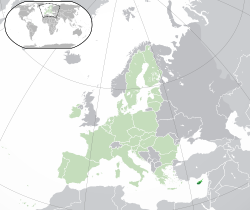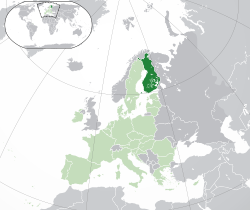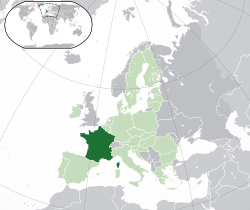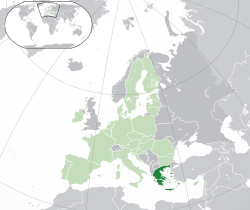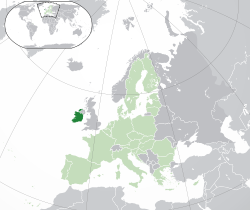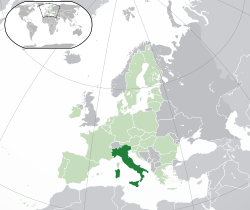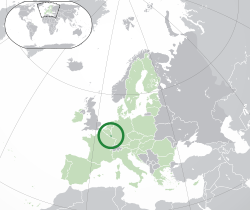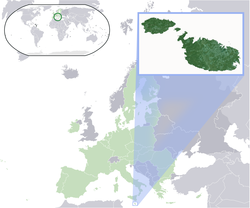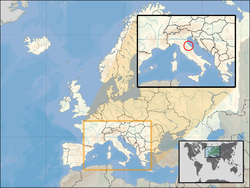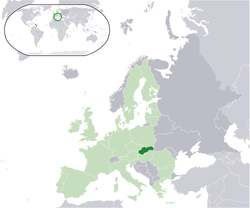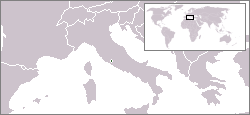Coins of the United States dollar – aside from those of the earlier Continental currency – were first minted in 1792. New coins have been produced annually and they comprise a significant aspect of the United States currency system. Circulating coins exist in denominations of 1¢, 5¢, 10¢, 25¢, 50¢, and $1.00. Also minted are bullion, including gold, silver and platinum, and commemorative coins. All of these are produced by the United States Mint. The coins are then sold to Federal Reserve Banks which in turn put coins into circulation and withdraw them as demanded by the United States economy.

The standard circulating coinage of the United Kingdom, British Crown Dependencies and British Overseas Territories is denominated in pennies and pounds sterling, and ranges in value from one penny sterling to two pounds. Since decimalisation, on 15 February 1971, the pound has been divided into 100 pence. Before decimalisation, twelve pence made a shilling, and twenty shillings made a pound.
There are eight euro coin denominations, ranging from one cent to two euros. The coins first came into use in 2002. They have a common reverse, portraying a map of Europe, but each country in the eurozone has its own design on the obverse, which means that each coin has a variety of different designs in circulation at once. Four European microstates that are not members of the European Union use the euro as their currency and also have the right to mint coins with their own designs on the obverse side.
Belgian euro coins feature only a single design for all eight coins: the portrait or effigy of the King of the Belgians. Previously, all Belgian euros depicted King Albert II and his royal monogram. Current coins depict King Philippe. Also part of the design by Jan Alfons Keustermans are the 12 stars of the EU and the year of imprint.
Austrian euro coins have a unique design for each denomination, with a common theme for each of the three series of coins. The minor coins feature Austrian flowers, the middle coins examples of architecture from Austria's capital, Vienna, and the two major coins famous Austrians. All designs are by the hand of Josef Kaiser and also include the 12 stars of the EU, Flag of Austria and the year of imprint.
There have been three sets of coins in Ireland since independence. In all three, the coin showed a Celtic harp on the obverse. The pre-decimal coins of the Irish punt had realistic animals on the reverse; the decimal coins retained some of these but featured ornamental birds on the lower denominations; and the euro coins used the common design of the euro currencies. The pre-decimal and original decimal coins were of the same dimensions as the same denomination British coins, as the Irish punt was in currency union with the British pound sterling. British coins were widely accepted in Ireland, and conversely to a lesser extent. In 1979 Ireland joined the Exchange Rate Mechanism and the Irish punt left parity with sterling; coin designs introduced after this differed between the two countries.

The Britannia is a bullion coin issued by the Royal Mint. It has been minted in gold since 1987, in silver since 1997, and in platinum since 2018. The reverse of the coin patterns feature various depictions of Britannia, a feminine personification of the United Kingdom, while the obverse features the effigy of the monarch of the United Kingdom with the legend around it.
The coins of the Australian dollar were introduced on 14 February 1966, although they did not at that time include the one-dollar or two-dollar coins. The dollar was equivalent in value to 10 shillings in the former currency.

Euro gold and silver commemorative coins are special euro coins minted and issued by member states of the Eurozone. They are minted mainly in gold and silver, although other precious metals are also used on rare occasions. Austria was one of the first twelve countries in the Eurozone to introduce the euro (€), on 1 January 2002. Since then, the Austrian Mint has been minting both normal issues of Austrian euro coins and commemorative euro coins in gold and silver.
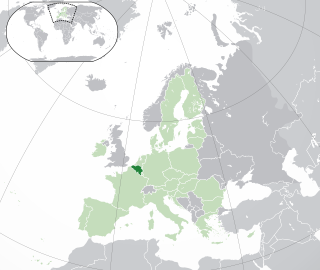
Euro gold and silver commemorative coins are special euro coins minted and issued by member states of the Eurozone, mainly in gold and silver, although other precious metals are also used in rare occasions. Belgium was one of the first twelve countries in the Eurozone that introduced the euro (€) on 1 January 2002. Since then, the Belgian Royal Mint have been minting both normal issues of Belgian euro coins, which are intended for circulation, and commemorative euro coins in gold and silver.

Euro gold and silver commemorative coins are special euro coins minted and issued by member states of the Eurozone, mainly in gold and silver, although other precious metals are also used in rare occasions. Finland was one of the first twelve countries in the Eurozone that introduced the euro (€) on 1 January 2002. Since then, the Mint of Finland Ltd. have been minting both normal issues of Finnish euro coins, which are intended for circulation, and commemorative euro coins in gold and silver.

Euro gold and silver commemorative coins are special euro coins minted and issued by member states of the Eurozone, mainly in gold and silver, although other precious metals are also used in rare occasions. Cyprus introduced the euro (€) on 1 January 2008. In 2000, in such a short time, the Central Bank of Cyprus has produced the first commemorative euro coin in silver. In 2010 the Central Bank of Cyprus has produced 2 more commemorative euro coin in gold and silver.

Euro gold and silver commemorative coins are special euro coins minted and issued by member states of the Eurozone, mainly in gold and silver, although other metals are also used on rare occasions. Malta introduced the euro (€) on 1 January 2008. In a short time, the Central Bank of Malta has been producing both normal issues of Maltese euro coins, which are intended for circulation, and commemorative euro coins in gold and silver.

Euro gold and silver commemorative coins are special euro coins minted and issued by member states of the Eurozone, mainly in gold and silver, although other precious metals are also used in rare occasions. Slovenia introduced the euro (€) on 1 January 2007. Since then, the Bank of Slovenia have been issuing both normal issues of Slovenian euro coins, which are intended for circulation, and commemorative euro coins in gold and silver.

Euro gold and silver commemorative coins are special euro coins minted and issued by member states of the Eurozone, mainly in gold and silver, although other precious metals are also used on rare occasions. Slovakia is scheduled to introduced the euro (€) on 1 January 2009. The National Bank of Slovakia, together with the Kremnica Mint, will be issuing both normal issues of Slovak euro coins, which are intended for circulation, and commemorative euro coins in gold and silver. These special coins have a legal tender only in Slovakia, unlike the normal issues of the Slovak euro coins, which have a legal tender in every country of the Eurozone. This means that the commemorative coins made of gold and silver cannot be used as money in other countries. Furthermore, as their bullion value generally vastly exceeds their face value, these coins are not intended to be used as means of payment at all—although it remains possible. For this reason, they are usually named Collectors' coins.
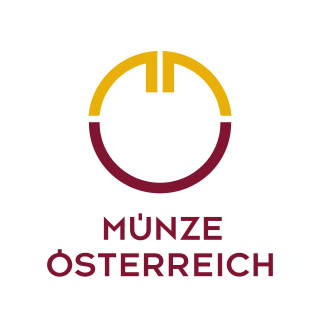
The Austrian Mint is located in Vienna and is responsible for minting Austrian coins. Since 1989 it has been a public limited company (Aktiengesellschaft) and a subsidiary of Austria's central bank Oesterreichische Nationalbank, which also has its headquarters in Vienna.
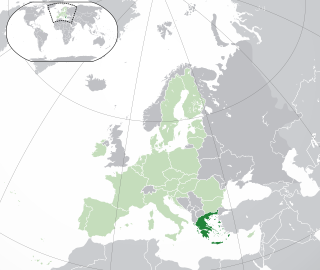
Euro gold and silver commemorative coins are special euro coins minted and issued by member states of the Eurozone, mainly in gold and silver, although other precious metals are also used in rare occasions. Greece was one of the first twelve countries in the Eurozone that introduced the euro (€) on 1 January 2002. Since 2003, the Mint of Greece have been minting both normal issues of Greek euro coins, which are intended for circulation, and commemorative euro coins in gold and silver.

Euro gold and silver commemorative coins are special euro coins minted and issued by member states of the Eurozone, mainly in gold and silver, although other precious metals are also used in rare occasions. Monaco was one of the first countries allowed to introduced the euro (€) on 1 January 2002, although they are not officially part of the Eurozone. Since then, the Monnaie de Paris in France have been minting both normal issues of Monégasque euro coins, which are intended for circulation, and commemorative euro coins in gold and silver.

Euro gold and silver commemorative coins are special euro coins minted and issued by member states of the Eurozone, mainly in gold and silver, although other precious metals are also used in rare occasions. Estonia joined the Eurozone on 1. January 2011. Since then Bank of Estonia has been issuing both normal issues of Estonian euro coins, which are intended for circulation, and commemorative euro coins in gold and silver.
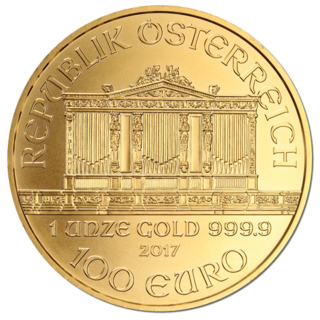
The Vienna Philharmonic, often shortened to Philharmonic, is a bullion coin of gold, silver, or platinum produced by the Austrian Mint. The coin is named for the Vienna Philharmonic orchestra, which inspired the design of both sides. It was introduced in 1989, as a one-troy ounce (ozt) gold coin with a face value of 2,000 Austrian schillings. It is one of the world's best selling bullion coins. In 2002, with the adoption of the euro currency, the nominal value of the one-ounce coin was changed to 100 euros. In 2008, the Mint introduced a one-ounce silver version of the coin with a nominal value of 1.5 euros. The silver coin is also one of the top selling bullion coins, ranked third in 2013. In 2016, the mint introduced a one-ounce platinum coin with a face value of 100 euros.
![Eurozone participation
.mw-parser-output .glossary dt{margin-top:0.4em}.mw-parser-output .glossary dt+dt{margin-top:-0.2em}.mw-parser-output .glossary .templatequote{margin-top:0;margin-bottom:-0.5em}
European Union member states
(special territories not shown)
.mw-parser-output .legend{page-break-inside:avoid;break-inside:avoid-column}.mw-parser-output .legend-color{display:inline-block;min-width:1.25em;height:1.25em;line-height:1.25;margin:1px 0;text-align:center;border:1px solid black;background-color:transparent;color:black}.mw-parser-output .legend-text{}
20 in the eurozone
1 in ERM II, without an opt-out (Bulgaria)
1 in ERM II, with an opt-out (Denmark)
5 not in ERM II, but obliged to join the eurozone on meeting the convergence criteria (Czech Republic, Hungary, Poland, Romania, and Sweden)
Non-EU member states
4 using the euro with a monetary agreement (Andorra, Monaco, San Marino, and Vatican City)
2 using the euro unilaterally (Kosovo and Montenegro)
.mw-parser-output .hlist dl,.mw-parser-output .hlist ol,.mw-parser-output .hlist ul{margin:0;padding:0}.mw-parser-output .hlist dd,.mw-parser-output .hlist dt,.mw-parser-output .hlist li{margin:0;display:inline}.mw-parser-output .hlist.inline,.mw-parser-output .hlist.inline dl,.mw-parser-output .hlist.inline ol,.mw-parser-output .hlist.inline ul,.mw-parser-output .hlist dl dl,.mw-parser-output .hlist dl ol,.mw-parser-output .hlist dl ul,.mw-parser-output .hlist ol dl,.mw-parser-output .hlist ol ol,.mw-parser-output .hlist ol ul,.mw-parser-output .hlist ul dl,.mw-parser-output .hlist ul ol,.mw-parser-output .hlist ul ul{display:inline}.mw-parser-output .hlist .mw-empty-li{display:none}.mw-parser-output .hlist dt::after{content:": "}.mw-parser-output .hlist dd::after,.mw-parser-output .hlist li::after{content:" * ";font-weight:bold}.mw-parser-output .hlist dd:last-child::after,.mw-parser-output .hlist dt:last-child::after,.mw-parser-output .hlist li:last-child::after{content:none}.mw-parser-output .hlist dd dd:first-child::before,.mw-parser-output .hlist dd dt:first-child::before,.mw-parser-output .hlist dd li:first-child::before,.mw-parser-output .hlist dt dd:first-child::before,.mw-parser-output .hlist dt dt:first-child::before,.mw-parser-output .hlist dt li:first-child::before,.mw-parser-output .hlist li dd:first-child::before,.mw-parser-output .hlist li dt:first-child::before,.mw-parser-output .hlist li li:first-child::before{content:" (";font-weight:normal}.mw-parser-output .hlist dd dd:last-child::after,.mw-parser-output .hlist dd dt:last-child::after,.mw-parser-output .hlist dd li:last-child::after,.mw-parser-output .hlist dt dd:last-child::after,.mw-parser-output .hlist dt dt:last-child::after,.mw-parser-output .hlist dt li:last-child::after,.mw-parser-output .hlist li dd:last-child::after,.mw-parser-output .hlist li dt:last-child::after,.mw-parser-output .hlist li li:last-child::after{content:")";font-weight:normal}.mw-parser-output .hlist ol{counter-reset:listitem}.mw-parser-output .hlist ol>li{counter-increment:listitem}.mw-parser-output .hlist ol>li::before{content:" "counter(listitem)"\a0 "}.mw-parser-output .hlist dd ol>li:first-child::before,.mw-parser-output .hlist dt ol>li:first-child::before,.mw-parser-output .hlist li ol>li:first-child::before{content:" ("counter(listitem)"\a0 "}
.mw-parser-output .navbar{display:inline;font-size:88%;font-weight:normal}.mw-parser-output .navbar-collapse{float:left;text-align:left}.mw-parser-output .navbar-boxtext{word-spacing:0}.mw-parser-output .navbar ul{display:inline-block;white-space:nowrap;line-height:inherit}.mw-parser-output .navbar-brackets::before{margin-right:-0.125em;content:"[ "}.mw-parser-output .navbar-brackets::after{margin-left:-0.125em;content:" ]"}.mw-parser-output .navbar li{word-spacing:-0.125em}.mw-parser-output .navbar a>span,.mw-parser-output .navbar a>abbr{text-decoration:inherit}.mw-parser-output .navbar-mini abbr{font-variant:small-caps;border-bottom:none;text-decoration:none;cursor:inherit}.mw-parser-output .navbar-ct-full{font-size:114%;margin:0 7em}.mw-parser-output .navbar-ct-mini{font-size:114%;margin:0 4em}html.skin-theme-clientpref-night .mw-parser-output .navbar li a abbr{color:var(--color-base)!important}@media(prefers-color-scheme:dark){html.skin-theme-clientpref-os .mw-parser-output .navbar li a abbr{color:var(--color-base)!important}}@media print{.mw-parser-output .navbar{display:none!important}}
v
t
e Eurozone participation.svg](http://upload.wikimedia.org/wikipedia/commons/thumb/c/c6/Eurozone_participation.svg/301px-Eurozone_participation.svg.png)


